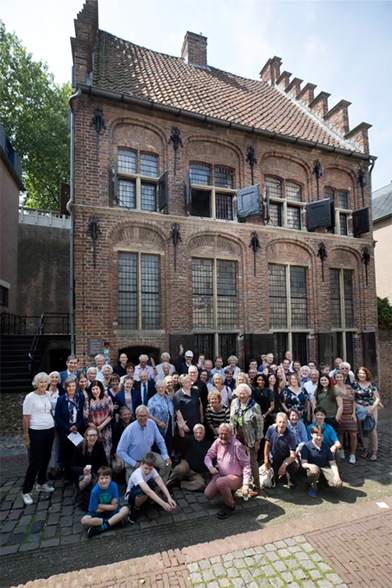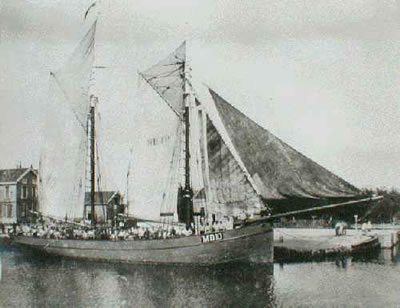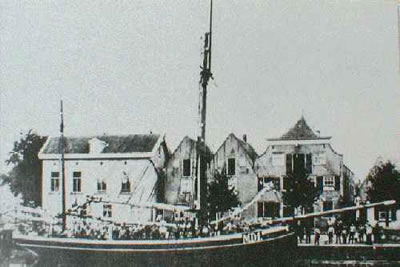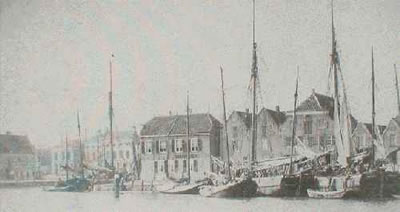The Youngest Branch at Middelharnis (part 2)*

 Het eerste deel handelde vooral over de bezigheden van de familie in Middelharnis sinds de start van het familiebedrijf daar in 1768 door Adrianus Quirinus. Een deel van hun initiatieven namen de Kolffen met andere ingezetenen van Overflakkee als bestuurders, soms onder de vlag van de Maatschappij tot Nut van ’t Algemeen; voor een ander deel echter traden zij op als zelfstandig ondernemer. Soms vervloeiden deze publieke en private takken van activiteit, zoals in het geval van de nutsspaarbank, de bedrijfsvoering waarvan al gauw een onderdeel werd van het takenpakket van de Firma Weduwe C. Kolff, zoals het bedrijf na de dood, in 1830, van A.Q.’s zoon Cornelis bekend zou staan. De portefeuille, zou men kunnen zeggen, van dit publiek-private conglomeraat vulde zich met de meest diverse besognes. Hier zal ik proberen daarvan een indruk te geven voor wat betreft de periode 1890 tot 1953, toen de laatste telg van de familie het eiland verliet.
Het eerste deel handelde vooral over de bezigheden van de familie in Middelharnis sinds de start van het familiebedrijf daar in 1768 door Adrianus Quirinus. Een deel van hun initiatieven namen de Kolffen met andere ingezetenen van Overflakkee als bestuurders, soms onder de vlag van de Maatschappij tot Nut van ’t Algemeen; voor een ander deel echter traden zij op als zelfstandig ondernemer. Soms vervloeiden deze publieke en private takken van activiteit, zoals in het geval van de nutsspaarbank, de bedrijfsvoering waarvan al gauw een onderdeel werd van het takenpakket van de Firma Weduwe C. Kolff, zoals het bedrijf na de dood, in 1830, van A.Q.’s zoon Cornelis bekend zou staan. De portefeuille, zou men kunnen zeggen, van dit publiek-private conglomeraat vulde zich met de meest diverse besognes. Hier zal ik proberen daarvan een indruk te geven voor wat betreft de periode 1890 tot 1953, toen de laatste telg van de familie het eiland verliet.
In 1892 telde Middelharnis twee rederijen, die van Slis en die van Kolff. Elk had toen tien sloepen, die op de visgronden van de Noordzee voeren, op zoutevis (gezouten kabeljauw) vooral en ook wel op haring. Elke sloep – toen al wel niet meer van hout, maar van staal – had zo’n dertien man, van schipper tot kofjeskoker, terwijl men bovendien had te maken met vast en los personeel: de scheepsbouwer, zeilmaker, mandemaker, smid, kuiper, de sjouwerman, de leverancier van lang-houdbare levensmiddelen. Een eigen touwslagerij, een lijnbaan, werd ingericht (aan het Beneden Zandpad; er is daar nog een Lijnbaanstraat). Nieuw want, netten, een schilderbeurt op de werf, dat alles verdiende aandacht. Maar de opbrengst was op den duur miniem. Meer dan eens is het gebeurd, “dat de vissers de voorschotten ad f. 3,- per week, die de reders gaven aan de huisvrouwen van de vissers, niet op hadden kunnen verdienen met de visvangst. Wanneer de afrekening kwam over wat de vis had opgebracht bij de IJmuidense visafslag en het deel dat elke vissersman zou moeten krijgen vastgesteld moest worden kwam het wel eens voor, dat de vissers niets kregen: de opbrengst was niet eens voldoende geweest om de eerste uitrustingskosten voor de sloep-naar-zee te brengen, opverdiend werd.” Soms ‘deserteerde’ dan een visser van zo’n sloep om een andere schipper te vinden die mogelijk gelukkiger voer. Een visser die vrouw en kinderen in Middelharnis had, maar op een Maassluise sloep gevaren had en niets had verdiend, deserteerde. Hij bracht vier dagen in de gevangenis door en de rechter oordeelde, dat het feit, dat hij niets verdiend had, geen excuus was voor contractbreuk.
 The first part dealt mainly with the occupations of the family at Middelharnis since Adrianus Quirinus (1745-1826) started the Firm in 1768. Part of these were of a gouverning nature, sometimes for the Nut van het Algemeen. Others dealt with private enterprises. Often these activities merged, as we can see with the savingsbank of the Nut. This activity soon became a part of the Firm of Wed. C. Kolff, under which name the firm became known after A.C.’s son Cornelius in 1830. The portfolio, one can say, of this public-private conglomerate was filled with a diverse number of activities. In this article I will try to describe the period between 1980 and 1953, when the last of our family members left the island.
The first part dealt mainly with the occupations of the family at Middelharnis since Adrianus Quirinus (1745-1826) started the Firm in 1768. Part of these were of a gouverning nature, sometimes for the Nut van het Algemeen. Others dealt with private enterprises. Often these activities merged, as we can see with the savingsbank of the Nut. This activity soon became a part of the Firm of Wed. C. Kolff, under which name the firm became known after A.C.’s son Cornelius in 1830. The portfolio, one can say, of this public-private conglomerate was filled with a diverse number of activities. In this article I will try to describe the period between 1980 and 1953, when the last of our family members left the island.
In 1892 Middelharnis numbered two shipping companies, that of Slis and the one of Kolff. Each had ten fishing boats that were used for fishing on the Northsea. They fished on cod, and at times also on herring. On each boat something like thirteen found steady work. Additionally personnel was hired for steady or temporary tasks on shore. Carriers, ship builders, sail, hive and barrel makers, blacksmiths, and delivery men. A ropery shop and a rope walk (lijnbaan) near the Beneden Zandpad (where the Lijnbaanstraat still can be found today). New rigging, new nets, painting on the ship yard, all needed attention. Returns in the end were small. More than once it occurred that the advance of three guilders, that ship owners gave to the housewives before the ships came back from fishing, could not be paid out of the returns from the catch. When the final account was settled with the IJmuiden fish auction and the part for each fisherman was calculated it could happen that the men were paid nothing at all. The returns had been less than the costs of furnishing the ship to go out to sea for fishing. Sometimes a fisherman ‘deserted’ the company to find better employment with more lucky profitable companies. One fisherman who sailed on a Maassluis based company’s vessel, but who had his wife and children at Middelharnis, deserted his company because he had earned nothing. He was sentenced to four days in jail. The judge concluded that the fact that he had not earned anything was no reason to break a contract.
* Sub-title of this article at De Colve has been: “Wat je hand vindt om te doen – De Jongste Tak te Middelharnis” which I translated freely as “Things one finds to do – The Youngest Branch at Middelharnis” – Source of image: Middelharnis in vroeger eeuwen (See at the Links Pages: Middelharnis).
| Image: Kolff’s warehouse (the building on the right) at a Middelharnis quay, beginning 1900’s. Ship is MD1, not one of Kolff’s, but of the other ship owners at Middelharnis: P.L. Slis & Son. Source of this image and images at next pages: Middelharnis in vroeger eeuwen (See at the Links Page: Middelharnis). |
More than once a ship got lost at sea. During World War I often because a ship hit a mine. For support to the widows of the men that perished at sea the Vissers Weduwen Fonds (Fund for Fishermen’s Widows) existed at Middelharnis. Management came into the hands of our cousin Agaath (CBB XVk2) (1889-1951), daughter of ‘young’ Cor, who died in 1923. The capital of this fund must have been around 200.000 guilders. Payments amounted to one or two guilders a week. Even until after World War II – on Saturday afternoons, when all the other work was done – the youngest servant of the firm brought the hundred or so guilders on his bicycle to the widows’ homes, after this had been prepared by miss Kolff. But this was already much later in time. The last shipping boat had by then been long sold to Vlaardingen (in 1921). The 1914-1918 War had been the cause of the ruin of that part of the company. What was left of the firm after 1918?
In the 1930’s and 1940’s four men worked at the office and in the warehouse, further there was a represetative who had a driving licence. In 1943 one of the office clerks and the warehouse assistant were put to work in Germany on the order of the occupying power. The remaining employees had to fill in their tasks. The activities were then (apart from the Vissers Weduwen Fonds): the wholesale and other trade in wines, distilled and non-alcoholic drinks, the wholesale in groceries, the Nederlandse Bank agency as well as the agency of the Nutsspaarbank Middelharnis-Sommelsdijk, the agency of the Brandverzekeringsmaatschappij Tiel-Utrecht (fire insurance company, also included insurance of harvests in barns), settlements of bills of exchange and promissory notes, the brokers’ agency R. Mees & Zonen at Rotterdam, and – to conclude this list – several stewardships in polder administrations.
In the business of wholesale there was a lot to do about the high excise taxes on distilled drinks and the controlling on that by officials. Direct delivery to licensed shops and café’s was rather simple. In these cases the excise taxes were paid by the licencee. For wholesale companies like Kolff’s this was different. Monthly orders were placed, such as with Distilleerderij ‘De Graauwe Hengst’ of Daniël Visser & Zn at Schiedam. Transporter was usually a skipper from Middelharnis. Upon arrival of the ship this was reported to the office and the tax collector was informed when the transport was to be handed over. Meanwhile the goods had to be kept at the ’temporary non-taxed’ storehouse of Kolff at the Oost Achterweg. Immediately after the tax collector checked the goods with the bills provided by the distillery (How is described at the Dutch section – I have had to leave that out here; Marius [Ed.]). It was not allowed to store other goods at this storehouse. Not a drop was to be taken out of this storehouse without the knowledge of the tax collector.
The firm always had a lot of drinks in stock, but they were only allowed to sell it after registration and payment to the tax collector had been arranged. For that a detailled form had to be delivered to the tax collectors’ office. The office checked the goods thoroughly before they could be sold. After this check the goods could be transported to a ‘shop’ across the street from where, with license, the drinks could be sold. Every following Wednesday the tax had to be paid on the sold drinks.
When Holland was invaded by Germany on May 10, 1940, all traders in distilled and other alcoholic beverages were ordered to destroy all their distilled goods. While many of the smaller tradesmen followed this order our cousin Agaath handed in, the very same day, her ‘list’ of the distilled goods to the tax collector in the ‘non-taxed’ storehouse. These distilled drinks were then not sold, but placed in the wine cellar below the residence and office at the Voorstraat. They used all they had: pots and cans and bottles, to store the drinks. The carrying and bottling took two full days. In the shop the air was filled with alcohol and the floor had some centimeters of liquid becasue of the spoiling, as employee Wittekoek later remembers. Subsequently they built little walls before the pigeon holes for the more expensive wines. Over the entrance of this floor a steady brick floor was laid. Later in that year, when everything had turned to a more relaxed situation, some of these measurements were made undone. The liberation, some years later, was celebrated with champagne, while owners of café’s that were custumors each got a litre of self-made ‘oranjebitter’: a tasty mix of sirup of orange with genever (similar to gin) and brandy.
The company was not the biggest wholesaler of groceries on the island. But it had the sole rights to sell high quality products such as the ones of Hero (canned vegetables and fruits, etc.), Tjoklat chocolade, barrels of zuurkool (sauerkraut) of Peter Verburg from the province of North-Holland, and more.
Furthermore there were the several banking activities. Note that at Kolff one could not open a proper bank-account or arrange for bank payments. Only a savings account could be opened. However there was a constant and continuous stream of money in the office. The entire island was provided with money by Kolff’s Nederlandse Bank agency. Apart from the vault of the company the firm had placed a Martens’ vault where there was a steady provision of banknotes and coins of something like 30,000 guilders in value. Being the ‘correspondent’ our cousin Agaath was the only person who knew the ciffer combination of the safe. In case of absence or illness, the only other person on the island who knew this code (and that of the Kolff safe) was the lawyer Mr L.J. den Hollander. Private persons as well as companies could come daily to exchange larger notes into smaller ones or coins, and vice versa (only the smaller coins could be exchanged at the post office). The demand for smaller notes and coins was always larger than the other way around and so these had to be requested weekly from Rotterdam. Notes with greater value were sent by registered mail in enveloppes sealed properly with varnish stamps. Smaller notes and coins were recieved in locker boxes that arrived with the ‘gentleman’s’ boat, the ‘Middelharnis’. During the journey the captain was responsable for the value: he kept the heavy metal vault in his own cabin or in the wheel-house. The currency reform in September 1945 was handled by the agency of Kolff for the island (to get rid of World War II black market money a currency reform, was initiated in 1945 by State Secretary Lieftinck; every resident had to hand in all his money and got a ’tientje’ – ten guilders – from the state in return until all was settled and cleared). Ofcourse this was a tremendously heavy job. All the counting and other work was done in Agaath’s back-room, where soon boxes of invalid bank notes piled the walls.
For the Nutsspaarbank accounts: around 1940 the number of savings accounts was around 500. For the primary schools there was an arrangement of savings through the schools. The savings boxes of the children were kept at the schools. Every Monday morning the children could add money to their boxes and the teacher noted the amounts. Twice a year the boxes were collected and emptied in the office. Coins were then sent to the post office. The employees of the firm had to do a lot of counting, not only for the childrens’ savings by the way.
The financial administration of a number of polders and ‘waterschappen‘ (body of surveyors of the dikes) was not very sizable and could be performed as an activity on the side. The insurance agency for the ‘Tiel-Utrecht’ however was fairly large. For the personnel this especially meant many errands for quittances and the keeping up of the enourmous books with the policies.
Furthermore were there the recoveries in cash and debts for the bank of Mees and for other banks, that did not have their own establishment on the island. Also the quittances of the Firm Kolff has to be kept up to date. Altogether a lot of work for Hannie Wittekoek of the Firm Kolff, and of the three so-called wissellopers (thos who collected the money) on the island (the other two worked for the Rotterdamsche Bankvereeniging and the Nederlandsche Handel Maatschappij, the Dutch Trade Society). It concerned around ten thousand guilders monthly. A certain amount of stress constancy was required for this job. At times debtors raged on the ‘wissellopers’.
Miss Agatha Kolff and her employees cooperated well, such is the impression. The only difference being that of the professional positions. Wages were not high. J.A. Wittekoek, who arrived as youngest clerk in 1939, earned an amount of Dutch Guilders 7.50 a month. Through the large variety of activities however he learned a lot and fast. That was an advantage. Many of the clerks, later, found good positions elsewhere. Wittekoek said about his work that he “felt that he was working for a trustworthy company that had a rich history.” It was not just at the ‘Liberations’ champagne that one met each other under relaxed circumstances. Saturday mornings everybody was ‘at home’, that is to say: in the office. There they wrote the receipts, the wissellopers and other employees checked the supplies, and the housekeeper, Nellie Smitshoek, welcomed each one with a cup of hot chocolate. After one o’clock, the end of the official working week, the employees were expected back to write new orders or, as we saw, arrange for delivery of the payments to the Vissersfonds. One can see that in the mixed Firm of Kolff work and private activities could not exactly be seperated. There was no clear difference between work and spare time. On Sunday mornings one could find Wittekoek again back at the office: to arrange for the mail, and to walk ‘Wallie’ cousin Agatha’s dog.
|
|
